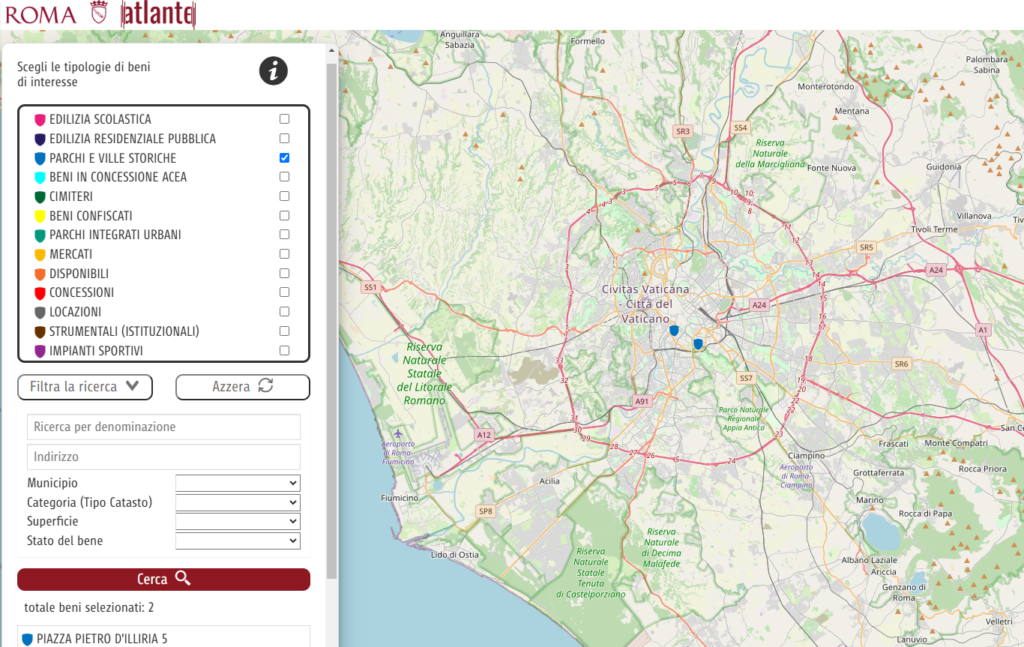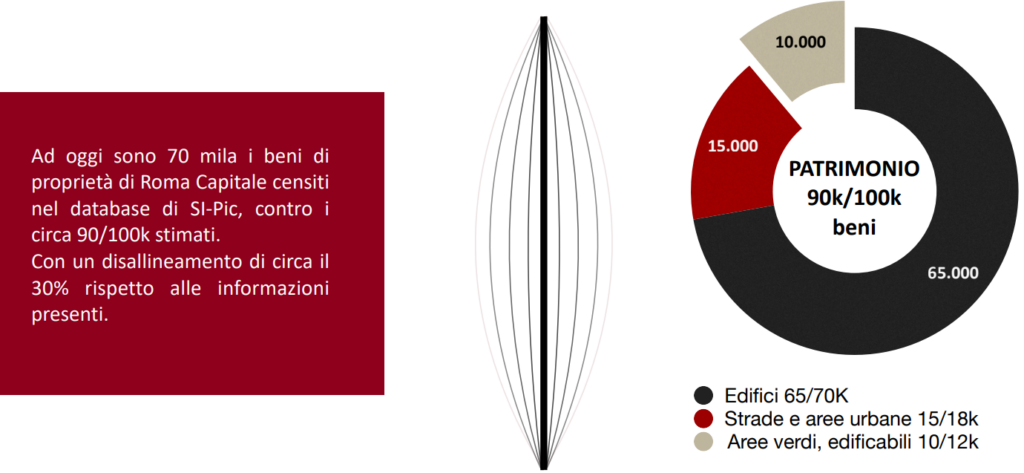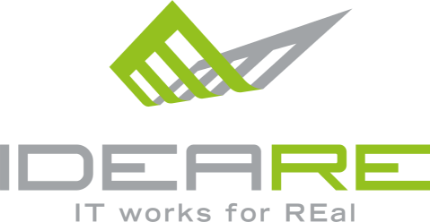The management of public real estate represents one of the most complex and strategic challenges for a metropolis like Rome. With a history spanning over two thousand years, the city is a mosaic of historic buildings, streets, green areas and cultural assets of inestimable value. However, this richness also entails significant difficulties in the cataloguing, maintenance and valorisation of the assets, which are often spread across different platforms and archives. In this context, the Atlante project emerges as an innovative and integrated solution, capable of responding to these needs with a state-of-the-art technological approach. Developed in collaboration with Ideare S.p.A. and based on the REFTREE platform, Atlante aims to transform the capital's heritage into a strategic lever for the city's economic, social and cultural development. The article explores the project's technical details, key figures, objectives and its impact on the city and its citizens.
Atlas is an application located within the Geoportal of the Municipality of Rome and it is the computer system dedicated to the Census of the huge Real Estate Patrimony of Roma Capitale.

It is open to citizens and will allow them to search in a simple and intuitive way by City Hall, Address, State, Category and Area, and by clicking on the placeholder on the map, the individual property sheet.

The system is linked with the Roma Capitale databases and is constantly updated. To date, it is under construction, but some functionality is already visible on the Portal.
The context of Roma Capitale Heritage.
Roma Capitale holds an immense and varied property stock, estimated between 90.000 e 100.000 assets, including:
– 65,000-70,000 buildings
- 15,000-18,000 roads and urban areas
- 10,000-12,000 green and building areas

The estimated mismatch between the data in the current system (SI-Pic) and the actual assets is approximately 30%attributable to three main factors:
1. Incomplete and uneven digitisation: Many assets, especially those documented before the digital era, have not yet been uniformly recorded in the system. For example, some 5,850 undigitised archive positions containing about 30,000 records account for a significant part of the mismatch.
2. Lack of a standardised cataloguing system: The lack of shared rules at national level has led to data discrepancies, making integration between the various databases difficult. For example, 540 schools were identified without adequate cadastral references out of a total of 1,500 surveyed.
3. Overlaps and structural complexity: Assets such as historic buildings, roads and parks often have fragmented or inconsistent stacking situations. This not only complicates management, but also affects the capacity for allocation and maintenance.
This mismatch leads to significant inefficiencies, such as delays in responding to requests related to public real estate, lack of capitalisation of extraordinary maintenance works and difficulties in accessing credit, thus penalising the entire community.
Technical details of the Atlas Project.
Atlas is an integrated system using the REFTREEalready in use at several large Italian organisations. Among the main technical aspects of the project
– Integration with existing systemsAtlas interacts directly with platforms such as JRoma (accounting system), Seicon (federated database) and Siscat (municipal cadastral system). These links ensure the consistency of up-to-date data and simplify information flows between the various departments.
– Cloud technologies: The platform leverages certified cloud services to ensure scalability, security and continuous access to data, reducing local infrastructure costs.
- Advanced interoperabilityIt uses interoperability standards such as RESTful APIs to enable dynamic integration with new applications or databases.
– Modular architectureEach module is designed to perform a specific function (inventory management, maintenance, cost monitoring), facilitating future upgrades without interrupting system operation.
– Advanced technologies: 3D Surveys, Modelling HBIM (Building Information Modelling) and high-resolution photogrammetry.
– Automation: Digitisation and reclamation of approximately 30,000 documents still in paper format.
Partnerships and Collaborations.
The partnership between the Municipality of Rome e Ideare S.p.A. was launched in 2021, structured through a series of well-defined phases. Initially, exploratory meetings were conducted to identify the specific needs of the municipality in terms of asset management. Later that year, a feasibility study was drafted that laid the groundwork for the 'Roma Capitale Census Project'. The partnership faced significant challenges, including the integration of different legacy systems, the alignment of procedures between the various administrative units and the training of staff on the new system. Thanks to close cooperation between the parties, the project was officially launched in 2023 with the kick-off and the start of the first operational phases.
Project Objectives.
1. Transparency and accessibility: to provide asseverated data to internal and external users, making the assets searchable through an intuitive interface.
2. Administrative efficiencyto reduce the time spent by offices on manual checks, currently estimated at between 70% and the 80%.
3. Economic valorisationalign data to estimate the real value of assets, projected beyond the EUR 6 billionand to budget for assets that have not been surveyed.
The Technologies Underpinning Atlas.
The Platform REFTREE by Ideare S.p.A. is at the heart of the project. With over 2 million properties already managed in Italy, it represents a consolidated and scalable solution. Among the technological advantages:
– Centralised managementIt unifies management, inventory and maintenance.
– Solutions in continuityIt minimises risks and transition times by using technologies already in use at Roma Capitale's in-house companies.
– New functionalitiesdedicated applications, such as the My ERP app for tenants, for reports, maintenance requests and payments.
Impact on the City and Citizens. The project promises tangible benefits for the community:
– Total transparency: The real estate assets will be explorable through a public portal that will make it possible to view information on available assets, allocations made and social uses.
– Operational efficiency: Reducing the response time to requests will significantly improve citizens' experience when dealing with the public administration, especially for requests related to public housing.
– Social Enhancement: Faster identification of assets intended for social purposes, enabling associations and non-profit organisations to access spaces and facilities in a transparent manner.
– Active participation: Through the My ERP app, citizens and tenants will be able to manage reports, maintenance requests and payments digitally, simplifying communication and business management.
– Economic benefits: More careful management of public assets will reduce the economic losses associated with misalignment and allow these resources to be reinvested in projects of collective interest, such as extraordinary maintenance and new public services.
– Environmental Sustainability: The adoption of technologies such as 3D surveying and HBIM modelling will make it possible to plan maintenance and energy efficiency measures, helping to reduce environmental impact.

Roadmap and Project Phases The project is divided into several phases, with a roadmap covering the period 2023-2025:
1. Phase 1 – Analysis and Design (2023):
- Creation of the single database: Consolidation of data from existing systems such as SI-Pic and GeoRoma.
- Definition of the new taxonomy: Development of a standardised model for the cataloguing of assets.
- Integration planning: Identification of the interfaces needed to connect Atlas to other platforms.
2. Phase 2 – Implementation (2024):
- Data migration: Transfer of existing data into the new system with consistency check.
- Integration with external applications: Link with systems such as JRoma and Seicon to automate workflows.
- Staff training: Training sessions for operators involved in data management.
3. Phase 3 - Consolidation and Operation (2025):
- Release of the My ERP app: Implementation of functionality for tenants, such as payment management and maintenance requests.
- Monitoring and optimisation: Evaluation of system performance and implementation of any improvements.
- Completion of the inventory: final census of all assets and publication of data on citizen-accessible platforms.
The Costs of Misalignment
The current mismatch between census data and actual assets has high costs for Roma Capitale: it is estimated that approximately 20% of unrecognised assets represents an unrecognised value of more than 1.2 billion. This value could be exploited to improve access to credit or for infrastructure investments. In addition, the lack of capitalisation of extraordinary maintenance work resulted in potential losses estimated at around 50 million per yearnegatively affecting the valuation of assets. Finally, administrative inefficiency due to the time spent by offices on manual assessments, estimated at between 70% and the 80%, results in additional operating costs of millions of Euros each year, further slowing down asset management activities.
Conclusions
The project Atlas, realised with the support of Ideare S.p.A. and based on REFTREErepresents a fundamental step for Roma Capitale in the management of its real estate assets. Using advanced technologies, the project aims to transform the heritage into a lever of growth for the city, guaranteeing transparency, efficiency and sustainability.
The implementation of Atlas will not only improve the management of existing assets, but also constitute a replicable model for other public administrations in Italy and abroad.
